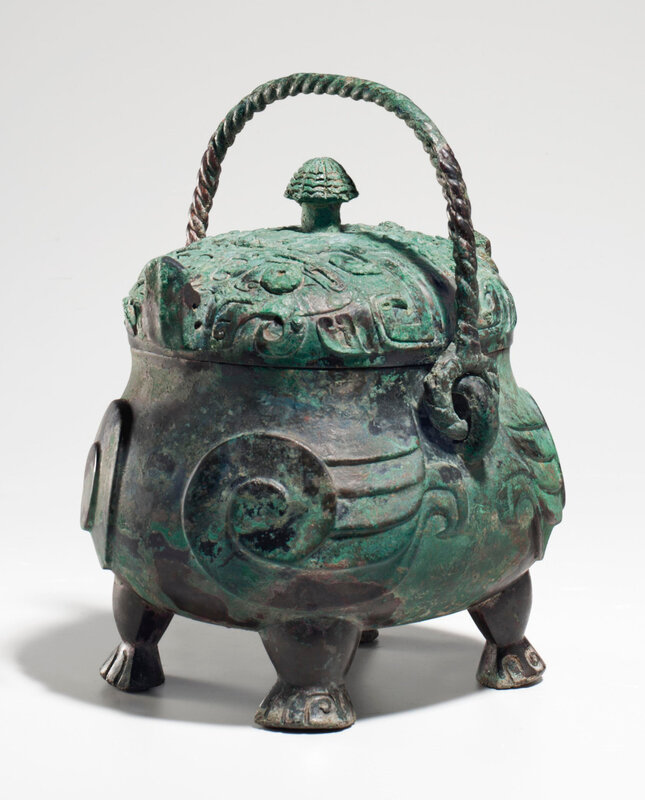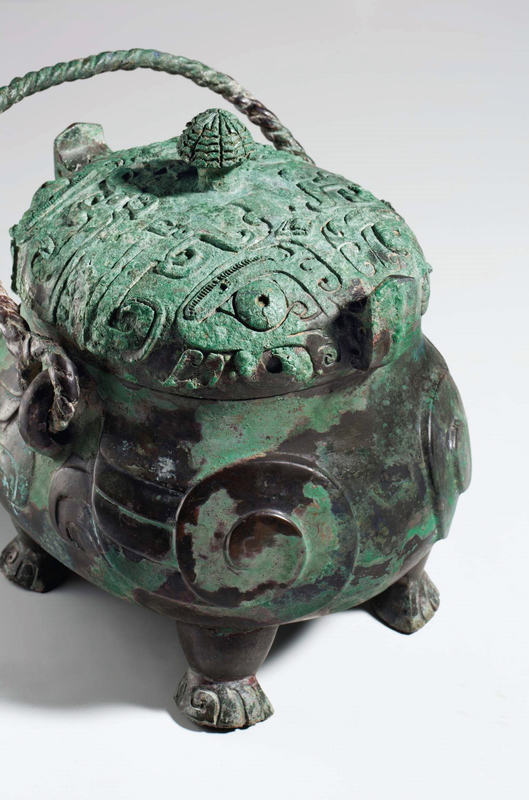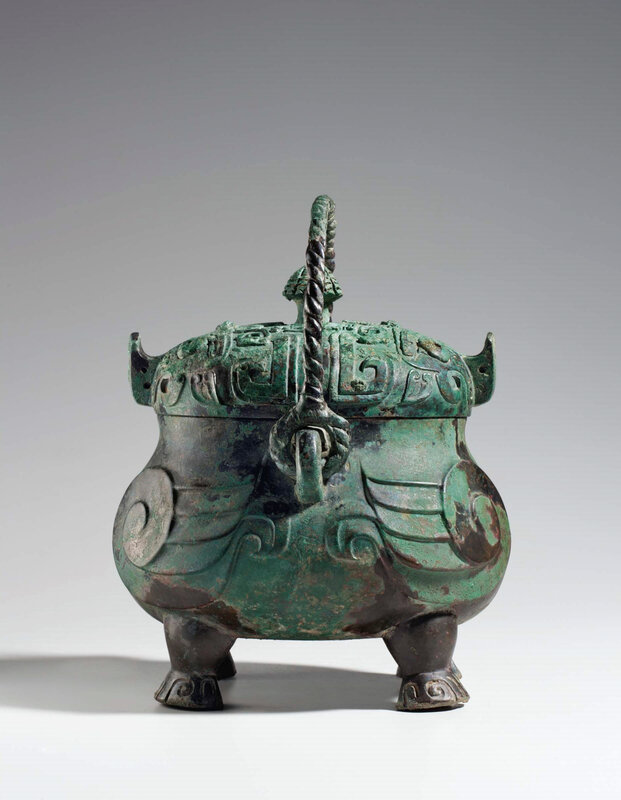A very rare and exceptional bronze ritual owl-form wine vessel, xiao you, late Shang dynasty, 12th-11th century BC



Lot 1220. A very rare and exceptional bronze ritual owl-form wine vessel, xiao you, late Shang dynasty, 12th-11th century BC; 10 in. (25.5 cm.) high with handle, 8 in. (20.3 cm.) across. Estimate On Request. Price realised USD 1,143,750. © Christie's Images Ltd 2013
The vessel is well cast in the form of two addorsed owls with plump bodies raised on four stout legs with splayed feet, and the sides are cast in soft relief with simplified wings sweeping back from the rounded breast to a pair of loops attached to the rope-twist swing handle. The domed cover is finely cast in crisp relief at each end as the head of an owl with upturned beak, domed circular eyes with recessed pupils, narrow, hair-detailed brows, and small ears. Behind each head is a pair of confronted dragons with long snouts that flank the base of the finial which is divided into eight cicada segments. The bronze has a mottled dark grey and brown patina and malachite encrustation, box.
Provenance: Private collection, Japan, prior to 1998.
Galerie Christian Deydier, Paris.
Exhibited: Paris, Galerie Christian Deydier, Biennale des Antiquaires, 2002.
Note: Vessels of this unusual addorsed owl form appear to have been made primarily during the Shang dynasty, and are of two different types; those covered all over with dense decoration and those of more austere, simplified design, exemplified by the present magnificent example.
Those of the first, ornate type, densely decorated with fine scale-like feathers, leiwen grounds and sometimes additional small bird motifs, are represented by three examples illustrated by R.W. Bagley, Shang Ritual Bronzes in the Arthur M. Sackler Collections, Arthur M. Sackler Foundation, 1987: one in the Freer Gallery of Art, p. 371, fig. 63.4; one in the Sumitomo Collection, Kyoto, p. 115, fig. 154; and another in the Fitzwilliam Museum, Cambridge, p. 371, fig. 63.3. Another in the Avery Brundage Collection is illustrated by d'Argencé, Ancient Chinese Bronzes, San Francisco, 1966, pl. XVIII (B).
Two other vessels appear to be a bridge between the first and second types. The bodies are completely decorated with small scale-like feathers and leiwen, but the decoration is more flat-cast and the shape of the wings is very similar to those of the second plain group. One is an example from Zhuzhou, Hunan province, illustrated in Wenwu, 1960:3, p. 29, fig. 2, and the other is in the Winthrop Collection, Harvard Art Museums, illustrated by Bagley, op. cit., p. 115, fig. 153. The beaks of the former are hooked, while the beaks of the latter are upturned like that those of the present you, and like the present vessel both have a rope-twist handle.
The second, plain group, which includes the present you, shares the same basic form, but has a smooth surface decorated only with simplified wings and facial details cast in crisp relief creating an elegance of form devoid of unnecessary distractions. The closest comparable you to the present vessel appears to be one of approximately the same size (25 cm. high) in the Hubei Yingcheng Wenhuaguan which is illustrated in Zhongguo Qingtongqi Quanji - 4 - Shang(4), Beijing, 1998, p. 152, no. 156. Like the present you, the heads of the owls on the Hubei Yingcheng example exhibit unusual 'eyebrows' with a combed, hair-like texture. Another unusual feature of the present vessel is the inclusion of the pair of confronted dragons behind the owl heads, rather than the more usual C-shaped horns that appear on most of the other published examples. A smaller (18.5 cm. high), but other otherwise very similar you to the present vessel and the Hubei Yingcheng example, but lacking the 'eyebrows', as well as the pair of confronted dragons behind the owl heads, is in the Shanghai Museum and illustrated ibid., no. 157.
Other related vessels of the plain group, but with hooked, rather than upturned beaks and cast with more distinctively owl-like facial features, rather than the taotie-like features of the present vessel, include the you from the Doris Duke Collection sold in these rooms, 21 September 2004, lot 145 (Fig. 1); the example from Shilou, Shanxi province, included in the exhibition, The Genius of China, Royal Academy of Art, London, 29 September 1973 - 23 January 1974, no. 81; the you included in the Kaikodo exhibition of 15 September - 26 October 1996, New York, no. 49; and the vessel illustrated by E. B. Avril in Chinese Art in the Cincinnati Art Museum, 1997, pp. 15 and 33, no. 7, which, like the Shilou you, features animal mask rather than loop terminals.

From the Doris Duke Collection. A very rare bronze owl-form covered vessel, xiaoyou, Shang dynasty, 12th-11th century BC; 9 in. (22.9 cm.) long. Estimate 600,000 - USD 800,000. Price realised USD 511,500 at Christie's New York, 21 September 2004, lot 145. © Christie's Images Ltd 2004
Cf. my post: A very rare bronze owl-form covered vessel, xiaoyou, Shang dynasty, 12th-11th century BC
A Technical Examination Report is available upon request.
Christie's. Fine Chinese Furniture, Archaic Bronzes and Works of Art, New York, 21 - 22 March 2013

/https%3A%2F%2Fprofilepics.canalblog.com%2Fprofilepics%2F1%2F0%2F100183.jpg)
/https%3A%2F%2Fstorage.canalblog.com%2F03%2F02%2F119589%2F96711876_o.jpg)
/https%3A%2F%2Fstorage.canalblog.com%2F11%2F31%2F119589%2F94773502_o.jpg)
/https%3A%2F%2Fstorage.canalblog.com%2F20%2F83%2F119589%2F94772815_o.jpg)
/https%3A%2F%2Fstorage.canalblog.com%2F26%2F72%2F119589%2F75604929_o.jpg)
/https%3A%2F%2Fstorage.canalblog.com%2F59%2F60%2F119589%2F26458628_o.jpg)


/image%2F1371349%2F20240406%2Fob_b23648_434058570-1644317966338216-88086167391.jpg)
/image%2F1371349%2F20240403%2Fob_6d5ae7_dp-28103-001.jpg)
/image%2F1371349%2F20240229%2Fob_8f31f9_431013694-1625286614908018-33034430839.jpg)
/http%3A%2F%2Fstorage.canalblog.com%2F79%2F20%2F119589%2F129837997_o.jpg)